 |
New York
Architecture Images-Chelsea Perry West |
|
architect |
Richard Meier |
|
location |
173 Perry Street and 176 Perry Street, corner of West Street |
|
date |
2002 |
|
style |
Late Modern (International Style III) |
|
construction |
concrete frame, curtain wall cladding |
|
type |
Apartment Building |
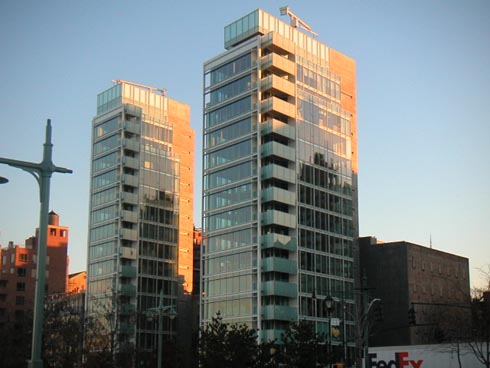 |
|
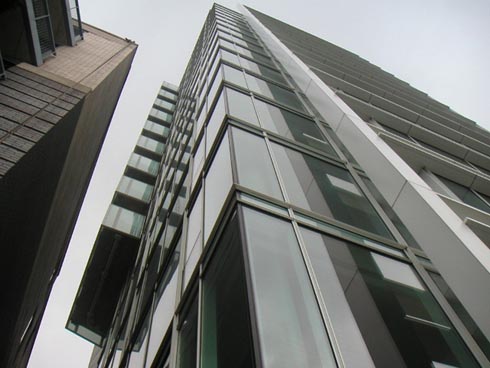 |
|
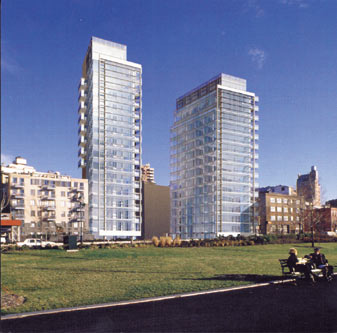 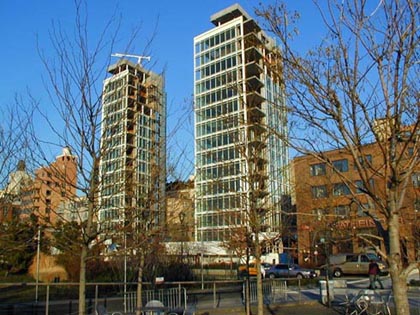 |
|
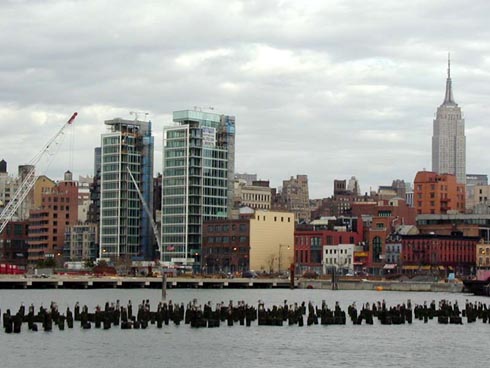 |
|
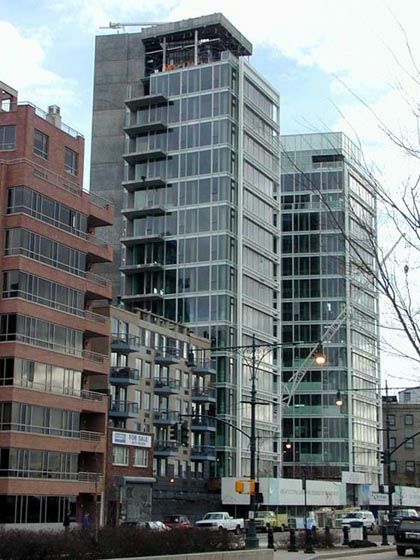 |
|
|
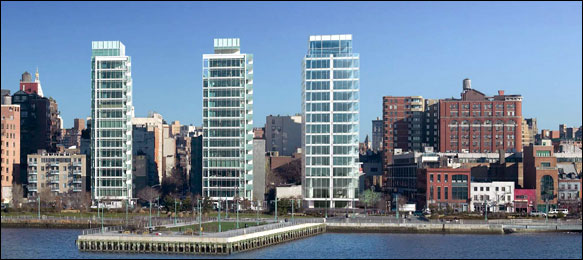
Internationally acclaimed architect Richard Meier brings his modernist signature to the New York City Skyline with 173/176 Perry Street, a pair of minimalist transparent towers overlooking the Hudson River in the historic West Village. 173/176 Perry Street is Meier's first building in Manhattan. Set for completion in late 2001, the towers will be heralded as an architectural landmark and considered the centerpiece of the West Side and its new Hudson River Park. For the consummate design statement, residents can experience the architect's total vision through his exclusive interior design plans. The exterior of the building is composed of insulated and acoustical clear glass. The seamless panes provide each full-floor condominium with stunning, panoramic views in a spectacular celebration of light and space, a Meier hallmark. In addition, star chef, Jean-Georges Vongerichten, owner of Vong and his self-titled restaurant in the Trump Central Park Hotel, will create a cafe-restaurant in the lobby of number 176. The area that surrounds 173/176 Perry Street is one of New York's great neighborhoods: the historic West Village. Cobblestone streets still pave most of the roads. Through the quiet streets and lanes, some of New York's finest restaurants, shops, and nightspots abound. Also, the City of New York has recently completed a new Park along the Hudson River which will serve as the backdrop to the towers. From the panoramic views of city, to the historic neighborhood, the 24 hour concierge, the fitness center, and the high-speed data capabilities, it is no wonder why 173/176 Perry Street will be a landmark for residential living in Manhattan. |
|
|
TURF The Art of Selling Luxury Condos as Art By MOTOKO RICH (copyright NYT) IZAK SENBAHAR, a developer of luxury condominiums in Manhattan, was commenting this week that neighbors should not complain about a glass tower overlooking the Hudson River that he is planning. It is being designed by Richard Meier for a site just south of the two Perry Street buildings the architect also created. "Simply by the fact that a new building by Richard Meier is being sold there, values will go up," Mr. Senbahar said. "Do you want to have a printer next to you or another high-class pure Richard Meier building next door?" Before he could continue, he was interrupted by Louise Sunshine, one of New York City's most aggressive promoters of high-end real estate. "No, don't say 'high class,' " she said. "Say 'work of art.' " In the latest marketing ploy for high-priced condos, Ms. Sunshine is trying to give real estate the cachet of fine paintings or sculpture. She plans to market the 31 apartments in the new Meier building, which broke ground in December, as "limited edition" residences. To underscore the point, Mr. Meier has commissioned clear acrylic models of the apartments — which he will sign and number to give buyers as a closing gift. It's an all-out effort to associate the prosaic arena of real estate with the flashier art world. Ms. Sunshine is doing everything but selling Andy Warhol-style images of Mr. Meier on the Internet: a gallery opening, a brochure designed by Massimo Vignelli and, for preferred customers, tours of a warehouse where Mr. Meier keeps models and sculpture. Mr. Meier called the marketing approach "flattering" and indicated he thought it appropriate. "There are not that many apartments like it," he said, in a conference room at his offices on 10th Avenue. Tomorrow, Mr. Senbahar and Ms. Sunshine will inaugurate their campaign with a party for those attending the Armory Show, one of the world's largest art fairs, which opens tomorrow in Manhattan. The crowd, which is promised to include only 20 real estate brokers out of the 350 people invited, can sip cocktails in the Charles Street Gallery — essentially a glorified real estate sales office, which contractors were scrambling to finish just days ago. On display will be renderings of the new Meier building and seven of the acrylic models. In addition, Mr. Meier, who has previously designed only 18 single-family houses, has agreed to display models of some of those rarities at the new "gallery," along with selections from his sculpture collection. The marketing pitch is part of Ms. Sunshine's broader attempt to link real estate and art in the minds of wealthy buyers. As part of a campaign to which she has given the slogan "Great Homes and Great Art Live Together," she has enlisted gallery owners willing to lend artworks to display in unsold apartments or in advertisements. In the case of Mr. Meier, Ms. Sunshine said she is showcasing the new building amid examples of his past work to attract "Richard Meier devotees." She said she believed such buyers would pay a premium to live in an apartment designed by the architect of the Getty Center in Los Angeles and the Museum of Contemporary Art in Barcelona. Mr. Senbahar, who with a partner, Simon Elias, is spending $100 million on the tower, plans to ask at least $2,500 a square foot, more than double the $1,268 average per-square-foot price for luxury real estate in Manhattan in the fourth quarter of last year, according to Miller Samuel Inc., a New York-based appraisal firm. With its glass facade, the new building, which is scheduled to be finished in March next year, will share an aesthetic with the two Meier towers on Perry Street. But where apartments in them were sold as raw space for buyers to customize, the new building has interiors and fixtures designed or selected by Mr. Meier. The bathrooms, for example, will have sinks and countertops of Surell, a synthetic material that can easily be molded, unlike the traditional marble or limestone chosen by architects in luxury buildings. "It is like lacquer, but smoother," Mr. Meier said, stroking the surface of a black lacquer conference table he designed. "It is not quite as cold as stone." He has also designed common amenities for the building, including a 50-foot pool, a fitness room, a wine cellar and a screening room with the same chairs he designed for the Getty Center. Mr. Meier is not, however, customizing each apartment. And because the building bears more than a slight resemblance to its two neighbors to the north, some local critics question how unique the new units are. "It seems a little ironic that these are being sold as limited edition Meier originals when it is now the third of the same tower, more or less," said Andrew Berman, the executive director of the Greenwich Village Society for Historic Preservation, which believes that the Meier towers do not fit in with older buildings in the neighborhood. For some in the art world, the marketing pitch seems disingenuous. "This is really stretching it quite a ways," said Richard Gray, an owner of the Richard Gray Gallery in Chicago and New York and the former president of the Art Dealers Association of America. "It's advertising license. I don't think it has the attributes that allow it to be seriously considered as a rare work of art." But others saw it as a clever way to package Mr. Meier's work as a brand that some luxury home buyers will covet. "It's not just about buying the building but the entire aesthetic and atmosphere," said Toshiko Mori, the chairwoman of the Harvard Design School. Other developers have selected star architects to design their condominiums. At Beacon Court, a tower being built on top of the new Bloomberg headquarters, the developer, Vornado Realty, has retained Cesar Pelli; RFR Davis, which has developed condos at 425 Fifth Avenue and the Impala on East 76th Street, hired Michael Graves. With prices in Manhattan skyrocketing, buyers expect more glamour in their homes. "Little by little, the bar keeps being raised," said Adrienne Albert, president of Marketing Directors, which helps developers sell high-priced real estate. "In order for people to understand if that's the right building for them to live in, they expect it to be more and more interesting and exciting." For Ms. Sunshine, who learned her trade as an apprentice to Donald Trump, the pitch for the new Meier building fits with her idea that real estate and art make natural partners. In a coming ad for a penthouse at the Time Warner Center, for example, she will use digital images of a Willem de Kooning painting, a Matisse sculpture and a 19th-century African sculpture, all borrowed from C&M Arts, a Manhattan gallery. Robert Mnuchin, the owner of C&M, said it was like "creating a mini-exhibition." Ms. Sunshine said she hoped to install art in other apartments she is trying to sell, including perhaps Mr. Meier's. For now, she said, he is the only architect getting the full star treatment. Although she represents Mr. Pelli's Beacon Court, for example, there are no plans to sell limited-edition Pelli apartments or to open an ersatz art gallery in his honor. Mr. Senbahar, the developer of the new Meier building, said most buildings do not qualify as art. "You can't give it a couple of bricks and two windows and call it art," he said. A selling point is that Mr. Meier has designed the kitchens, at back, right, and the pool, far right. 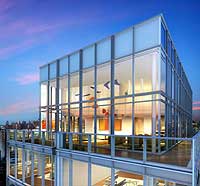 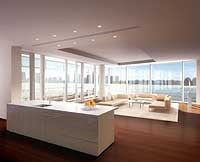 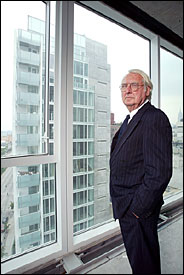 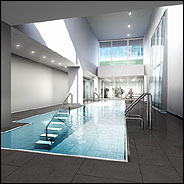 The architect, Richard Meier. Rich and famous fall out of love with the 'Faulty Towers' of New York By Charles Laurence in New York (Filed: 09/05/2004) Draped in glass with a soft aquamarine tint, and commanding uninterrupted views of the Empire State Building and the Statue of Liberty, the twin towers on Manhattan's waterside Perry Street should rank among the most desirable homes on earth. The towers were designed by the leading architect Richard Meier, and a who's who of the rich and famous - including Calvin Klein, the actors Nicole Kidman and Hugh Jackman, and the disgraced home guru Martha Stewart - rushed to buy flats at $1,000 per square foot. Martha Stewart paid $6 million for two floors of the north tower Klein, the designer, paid $20 million (£11.2 million) to buy and decorate a three-floor penthouse in the south tower, making him the biggest investor in the project. Before signing the cheque, he even went up in a helicopter to check out his views. For four years the apartments have been the talk of the town, ever since New Yorkers driving past the towers on the banks of the Hudson first saw their revolutionary glass "curtain" walls, and wondered what it might be like to live with the glitterati in such a place. Yesterday, they got an answer when the new issue of Vanity Fair landed on the news stands with a shocking headline: Faulty Towers. There is, it turns out, a giddy price to pay for architectural fabulousness and social prestige. The monthly service charge for doormen and cleaning has recently doubled from $2,000 to $4,000 (£2,200) - a significant increase even for multi-millionaires. Worse still, the very fabric of the glass-clad apartments appears to be failing. According to the increasingly irritable apartment owners, the ceilings leak, the heating fails and the balcony floors buckle. Perhaps inevitably, lawyers are said to be circling, ready to deal with residents' grievances. As if Ms Stewart, who paid $6 million (£3.3 million) for the top two floors of the north tower, did not have enough to cope with after her recent conviction for obstructing justice, she has also suffered flood damage. In a recent rainstorm, the magazine claims, her balcony overflowed, sending water cascading down the tower. Six levels below, Joe Castaldo, owner of the Style Council textile company, discovered that his expensive rosewood floor was so badly damaged in the downpour that it had to be ripped up and replaced. Some apartments are already on to their third new floor, the magazine claims. "You won't believe what's going on in these buildings. It's a microcosm of everything ugly in human beings - beautiful, beautiful architecture desecrated by scandal, greed and gluttony," Vincent Gallo, the film-maker and actor, told Vanity Fair. The towers were developed by the team that made a fortune in the 1990s with a series of Manhattan "boutique" hotels. "It felt like Star Trek: you know, going where no man has gone before," said Richard Born, one of the developers. Yet the excited owners were later taken aback to discover that the building's plumbing was set in concrete. They could not so much as move a sink or a bidet without drilling a hole in their downstairs neighbour's ceiling. When Michael Jackson, the British-born head of Universal Television and former chief executive of Channel Four, wanted to do just that, Mr Gallo - whose own apartment was newly decorated - firmly said "No". Many other residents have taken the same line. Paul Sinclaire, a friend of Calvin Klein, was the first to move in and had to walk a plank over an open drain to reach his door. When winter came, he discovered that the builders had forgotten to fit wall insulation. It was so cold that he "could not get out of bed". According to Vanity Fair, he was offered a discount to move temporarily into a hotel. While he was there, he says, someone stole his watch and television set. He also discovered that the building's doorman had been charging curious tourists to tour his home. Mr Castaldo recalled how he stood by his glorious glass wall one morning, admiring the rain streaming down it like a waterfall - and then reaching out a hand to discover that the water was flowing inside. "I fail to see how this is not going to go before Attorney General Eliot Spitzer," he said, referring to the legal official responsible for property laws and disputes. The problems continued. A gunman who has never been caught began taking potshots at the towers. Though the glass panels cracked, bullets did not penetrate them. It was enough to make even the most modest of homeowners complain, and the residents of the Perry Street towers are hardly that. Many had already made exceptional demands of the developers. Kidman, for example, begged them to install a secret passage between her apartment and the parking garage next door so that she need never appear in public. The request was turned down. Ms Stewart demanded that a special area be designated where her limousine drivers could wait for her. She, too, was refused and is now trying to sell her penthouse for $7.2 million. As for Klein, he has allegedly been pushing for doormen to be armed, for staff to wear designer uniforms, and for the gym to be moved to create more space for residents' mailboxes. Mr Gallo told the magazine: "I do object if Calvin suddenly wants an armed doorman, and I'm supposed to pay for it." Other concerns sound more petty. There have been complaints, for example, that Rita Schrager - the former wife of the hotelier Ian Schrager - has defied house rules that preserve the uniform appearance of the glass walls by hanging up white curtains. More and more original residents are moving out. According to estate agents, they may sell in disgust but they should make a profit. The design of the buildings still mesmerises New Yorkers, and the value of the apartments is assured. "The waterfront is becoming the new Fifth Avenue," confirmed Ron Teitelbaum, an estate agent. Some comfort, at least, for the disgruntled Perry Street residents. |
|
|
links |
PerryWest.com |